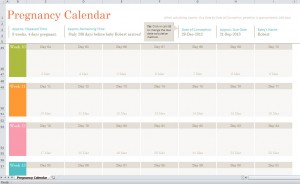
For fist-time mothers with brewing bundles of joy in their tummies, it’s not difficult to find more than a few self-proclaimed pregnancy experts touting their gestation wisdom.
From former mothers to self-help gurus to your nurse practitioner, just about every individual that crosses your path during gestation will be more than happy to offer their two cents on the experience. And while their advice is honest and valuable no doubt, pregnancy is a uniquely magical, highly individual experience. While many aches, pains and elation that expectant mothers experience during gestation bear similar qualities, no two fetuses will form the same, as will no two pregnancy symptoms will parallel one another.
However, one of the most crucial aspects to a safe, healthy gestation period is monitoring and planning, from both your doctor and you. From the kinds of nutrients you consume, to the activities you partake in, to those aches of nausea and soreness you may experience, developing a pregnancy calendar for baby monitoring is vital for both mommy and baby’s health.
How to Use My Pregnancy Calendar for Proper Baby Monitoring
According to WebMD, the average duration of a pregnancy lasts roughly 40 weeks. And while this period can be longer or shorter depending on your baby’s unique development and health, gestation is most often separated into three distinct trimesters.
In the Pregnancy Calendar template, these trimesters are separated by individually color-coded weeks and days. These calendar days contain ample room for expectant mothers to log in any specific, daily notes that pertain to their pregnancy woes, highs, appointments or occurrences.
These kinds of daily specifications may include:
- Feelings of nausea, sickness or pain
- Specific doctor’s appointments, and details you might need to remember for your visit
- Your baby’s first kick
- Any kinds of cravings or increase in appetite
While it might seem trivial at first to log in every painstaking cramp or feeling of fatigue, those daily details will help to form an overarching timeline of your pregnancy, and a storybook of sorts for you and your doctor to analyze should any issues arise. When it comes to ensuring a healthy, secure pregnancy, timing – and thoroughness – is everything.
On top of the space provided for daily monitoring and recording, the pregnancy calendar template also contains space for expectant mothers to log in their elapsed pregnancy period, time remaining before the pregnancy due date, a specific (or estimated) date of gestation, as well as the baby’s expected name.
Understanding Every Ache and Elation of Your Gestation Journey
Although no two women stand to experience identical issues and experiences throughout their pregnancy, there are a few tell-tale signs and benchmarks that help to define the trimesters.
First Trimester: Feeling Out Your Developing Fetus
The first trimester begins at conception and progresses towards the development of tiny fetus. A single, fertilized cell implants itself to the uterine wall, eventually forming into an apple-sized bundle of joy. He or she will be forming muscles and producing white blood cells to help build a stable immune system. And while your tiny tot will certainly be experience a tumultuous road towards human development, mothers stand to experience more than a few unexpected surprises as their body assimilates to the pregnancy.
Mommies in the earliest stages of their pregnancy tend to experience quite a bit of nausea, or most infamously defined as “morning sickness”. Mothers in their first trimester also tend to experience some breast tenderness, mood swings, and the absence of a menstrual period. Be sure to log any of these initial body changes in your pregnancy calendar.
Doctor’s visits will likely consume a fair share of your time during the first trimester, as your practitioner will likely perform a series of blood, pap smear and urinalysis tests to ensure the long-term health of your pregnancy.
Second Trimester: Settling In
As the gestation period progresses, expectant mothers can expect to start feeling some fetal movement in their second trimester.
By the 21st week of pregnancy, most babies begin feeling the urge to stretch their tiny limbs, offering up some serious jabs for their mommy’s tummy. And by the 22nd week, your baby’s senses will begin to mature quite rapidly, allowing him or her to begin processing their environment — and hearing your voice for the very first time!
As for the growing mommy, the second trimester is typically defined with increased energy, as the initial shock to your body is beginning to cease. However, many mothers have reported continued cramps, skin changes, increased appetite, and the appearance of varicose veins.
By the second trimester, your doctor will likely begin measuring the fetus for size and weight, as well as checking for a healthy heart beat. Your doc is likely to schedule an ultrasound around this time as well.
And of course, always ensure to log any detail – no matter how seemingly insignificant it may be – into your printable pregnancy calendar. The second trimester will be the time when your growing bundle truly starts to express its health, so keeping a close eye on daily occurrences is crucial.
Third Trimester: The Home Stretch
By the third trimester in the pregnancy calendar, both baby and belly will have reached peak sizes. Most babies will have reached up to 2.5 pounds, and 16 inches in length.
Because your body is tapping on the door for delivery, experiencing false labor symptoms can be quite common. But as any mother will tell you, there will be no denying when it’s truly time for you to deliver.
Download: Pregnancy Calendar
Related Templates:
- Pregnancy Diet
- Mom and Baby Checklist
- Using an Ovulation Calendar to Predict Pregnancy
- Weekly Calendar
- Auto Updating 2019 Calendar
View this offer while you wait!
